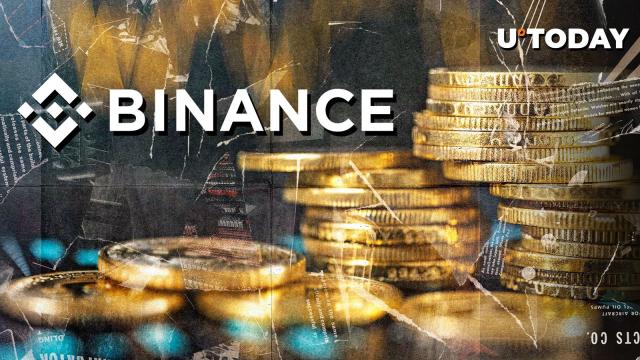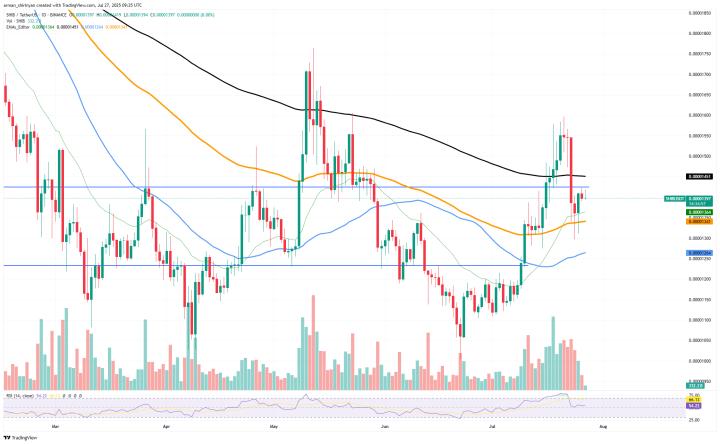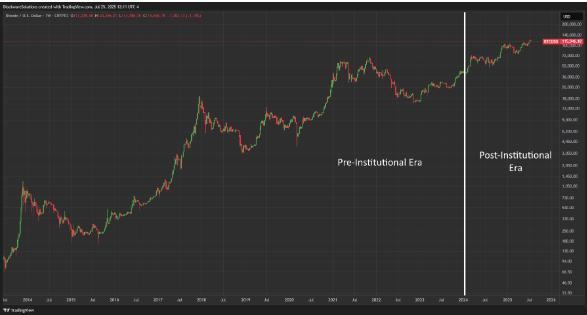Original Video: Michael Saylor
Compiled by: Odaily
The enterprise layout of Bitcoin reserves continues to heat up. Recently, multiple companies have accelerated their Bitcoin reserve strategies, with typical cases including:
Nasdaq-listed Profusa: Announced a stock credit agreement with Ascent Partners Fund LLC, planning to raise up to $100 million through issuing common stock, with all net proceeds to be used for purchasing Bitcoin.
H100 Group: Raised approximately $54 million additional funds, which will be used to seek investment opportunities within its Bitcoin reserve strategy framework.
Beyond these cases, many traditional enterprises are actively raising funds to build Bitcoin strategic reserves. Meanwhile, the potential "battlefield" of the pension market is also showing signs.
On July 18, the Financial Times reported that the Trump administration is considering opening cryptocurrency, gold, and private equity investment channels to the US retirement market managing $9 trillion in assets. It is understood that Trump plans to sign an executive order allowing 401(k) retirement plans to invest in alternative assets beyond traditional stocks and bonds. If this policy is implemented, listed companies focused on Bitcoin reserves or holding substantial Bitcoin equity may become hot investment targets in the pension market, with an appeal that could even surpass existing methods like spot ETFs.
In this trend, Strategy's business model is moving towards a broader stage. Previously, Strategy released the "BTC Credits Model" for evaluating Bitcoin-denominated equity value, and founder Michael Saylor also elaborated on the model's application and significance in a recent interview. Odaily has compiled the key content as follows:
[The rest of the translation continues in the same professional and accurate manner, maintaining the specific translation rules for proper nouns as specified.]The first method is to manipulate cash flow, investing all operating profits into Bitcoin, which would yield corresponding returns, involving $100 million in operating cash flow. I use this money to purchase Bitcoin. This way, I obtain $100 million in Bitcoin returns without diluting any shareholder equity, butrequires an operating company that can generate substantial cash flow to do this;
The second method is that if you sell equity at a price higher than net asset value (M times NAV), such as selling $100 million in equity at 2 times NAV, you will obtain $50 million in BTC returns. Of course, if you sell equity at an amount lower than NAV, you are actually diluting shareholder shares and will get a negative rate of return;
I believe that BTC return rate and returns are important because they provide investors with a simple, transparent, and immediate way to understand whether the management team is making value-added or dilutive transactions on any specific date. As long as listed companies are willing to dilute shareholder equity, they can almost raise any amount of funds. The real trick is to do this in a value-added manner. So these two metrics are important, but we have now solved this issue.
For example, if my cash flow is exhausted and BTC price rises, what would you do? If M is 10 or 5 or 8, this is not a complicated matter. When M is 10, you gain about 90% of the price difference, so selling $10 billion in equity would generate $9 billion in returns, which is a risk-free instant return. Essentially, this is not complex.
The problem is what happens if M drops to 1 or below? If you have no cash flow and M drops to 1, but you have $10 billion in Bitcoin on your balance sheet, what would you do? If you are a closed-end trust fund like Grayscale, or if you are an ETF (especially a closed-end trust fund), you would be powerless. Therefore, your trading price would be lower than M times NAV.
And this is precisely what people want to avoid. However, the special power of operating companies is to issue credit instruments. So if trading at a discount or the trading price drops to the normal market price, the real way to get out of trouble is to start selling credit instruments collateralized by company assets, which introduces the concept of the BTC credit model.
If I have $10 billion in Bitcoin, I can sell $100 million in bonds, or $100 million in preferred shares with a dividend yield of 10%. This is equivalent to 10x collateral. Therefore, Bitcoin's rating is 10, and now you can calculate the risk, the risk being that your $10 billion Bitcoin transaction might shrink to less than $100 million when the instrument matures. You can calculate like the Black-Scholes Model (Odaily note: Black-Scholes Model is a mathematical model in the financial field, widely used for pricing derivatives such as options)by using statistical methods, inputting volatility, BTC rating, deriving risk, and then calculating the credit spread, which we call BTC credit.
BTC credit represents the theoretical credit spread (relative to the risk-free rate) you need to offset risk, of course, plus the credit spread itself. If the BTC rating is 2, the credit spread will be higher than for a rating of 10; if the predicted Bitcoin volatility is 50, the credit spread must be higher than when Bitcoin's volatility is 30.
Therefore, if you input your Bitcoin return rate or annualized return into the BTC credit model, along with your expected Bitcoin volatility and Bitcoin price, you get the BTC rating, risk emerges, and the BTC credit model pops out. What we are doing is beginning to issue Bitcoin credit instruments, and our idea is to sell securities to a market orthogonal (completely unrelated) to the stock and Bitcoin markets, or an uncorrelated market.
In the U.S. retired dollar yield market. Many people don't know what Bitcoin is, don't know what Strategy is, they know nothing about our business model, but if we offer preferred shares with a 10% dividend face value, providing them with a 10% dividend yield and qualified income distribution, a qualified type of instrument, if your annual income is below $48,000, you can buy this instrument in the U.S. and get a 10% tax-free return.
Many people want 10%. The issue now is risk, and if it's 5 or 10 times collateralized, it doesn't seem so dangerous. If you are bullish on Bitcoin, my idea is simple: provide someone with high fixed income at extremely low risk. I believe Bitcoin collateral is a killer application. Strategically, we created a convertible preferred stock called "Strike" (stock code: STRK), which allows you to get 40% stock upside and an 8% face dividend.
Then we created a convertible preferred stock called "Strife" (STRF), offering a 10% yield. These two stocks are the most successful preferred stocks of this century. They are the most liquid, highest-performing, rising 25% when other preferred stocks trade down 5%.
They are the most successful because any security purely constrained by Bitcoin is always better. These equities are more valuable, convertible bonds are more valuable, these preferred stocks are more valuable because you are connecting to an asset that rises 55% annually, we put it into those instruments, and they will be very successful, go public and achieve stock price increases, and now the idea is that we can market to people.
We can sell 40% of stock appreciation to people, at which point Bitcoin might rise 80%, with downside protection and guaranteed dividends. So we call it "Strike". It's like a Bitcoin bonus, it's like getting a living allowance, you have enough funds for protection, you can be in the car, hold it forever.
This is for those curious about Bitcoin but afraid of the "roller coaster", like a "turbocharged" version of Bitcoin stock MSTR. But there are also many people who don't want to touch Bitcoin, they just want dollar returns, euro returns, or yen returns, but how many people in this world have such thoughts? The fact is that for all retirees, no one doesn't want to get an 8% or 10% dividend yield at extremely low risk.
This is why the credit market and fixed income market are larger than the stock market, what we are doing is using Bitcoin to generate such returns. If Bitcoin is rising and has already risen 55%, you can almost cut out any proportion of returns from 50%, as long as it's below 55%, it can be distributed to investors. And I believe Bitcoin's long-term highest prediction is 30%, but I think Bitcoin's annual return will always remain between 20% and 60%.
As long as Bitcoin's return rate is 20% or above, you can always sell these tools offering 6%-10% returns and exchange them for 20%-40% returns. Capturing the price difference for equity investors, so equity performance will outperform Bitcoin. As for convertible bonds, this is our financial engineering.
We are transforming the company, with the goal of outperforming Bitcoin by 50% to 100%. If you want to directly invest in Bitcoin, you can buy and hold BTC on IBIT. Through our stock, you will receive all the gains and losses of Bitcoin, along with all its volatility, STRKthis convertible bond is designed to provide you with 80% to 100% of Bitcoin's returns, while only bearing 10% of the downside risk. So we hope you can capture 80% of the upside, bear 10% of the downside risk, and receive guaranteed dividends. This is suitable for those who want to enjoy returns while mitigating risks, and who do not want roller-coaster-like volatility. This is almost to compete with IBIT, if I give you 80% to 100% upside returns, 100% downside risk, and no dividends, what would happen (IBIT)?
[The rest of the translation follows the same professional and accurate approach, maintaining the original structure and meaning while translating to English.]Computing power is in the hands of economic participants, political participants, Bitcoin miners, and technology providers. Compared to five years ago, the consensus among various parties is now more extensive. Moreover, I believe that mining driven by policy will ultimately be replaced by economic and technical participants.In my view, Bitcoin is actually more powerful than ever before. I am not worried about the current situation and will continue to maintain a positive outlook.
Reporter's questions about exchange KYC review
Let's be clear, you are not collaborating with exchanges or companies, but are in a Bitcoin world where exchanges are merely a medium. You can completely bypass them. The way people handle cryptocurrency exchanges today is dynamically evolving. As the digital asset environment becomes more flexible, we will see an explosive growth of innovation, occurring at both national and individual levels. What exists today may not be the same five years from now. There will be more freedom and privacy, and they will develop very good technologies that may spread to other parts of the world. Other countries will also make mistakes in KYC and review, rather than in privacy.
KYC is not a Bitcoin issue, but a nation-state and citizenship issue. If you find yourself in a particularly unfriendly country that deprives you of privacy or economic freedom, the answer is certainly to either use technologies from elsewhere, such as VPNs and firewalls, or obtain citizenship from another country.
Bitcoin is global, allowing participants from every country. Worldwide, Layer 2, 3, 4 technologies may be developed quickly. Some things done in a country where you do not reside may be illegal or culturally unacceptable in your country. As a Bitcoin holder, you might benefit from someone in another place. If you own Bitcoin in Cuba or North Korea, although profitable, these are illegal in some locations.
Similarly, many technologies will flow from the United States to countries that do not allow them. And technologies will flow from other countries into Europe where they may not be permitted. I believe this dynamic balance has no standard answer, with the best solution being protocols like the Bitcoin Lightning Network, which can provide the most sovereign-resistant and robust method of acquiring and circulating monetary assets.
So these developments are gradual, everything is evolving. Do not be too idealistic. The fact is, Bitcoin has now reached a market value of $2.3 trillion. We are in a good position, with the world's best and smartest technical personnel beginning to spend more funds on programming, innovation, and BTC Layer 2, 3 to solve all existing problems. Bitcoin is a movement, a technology, and a protocol that provides us with a hopeful solution path, better than any other protocol I currently know.







